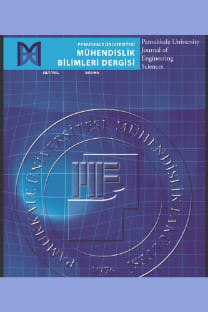Yonga levha üretim süreçlerinde pres süresinin enküçüklenmesi
Yonga levha, Pres süresi, Eniyileme
Minimization of pres time at particleboard production
Particleboard, Press time, Optimization,
___
- Ashori A, Nourbakhsh A. “Effect of press cycle time and resin content on physical and mechanical properties of particleboard panels made from the underutilized low-quality raw materials”. Industrial Crops and Products, 28(2), 225-230, 2008.
- Nemli G, Hiziroglu S. “Effect of press parameters on scratch and abrasion resistance of overlaid particleboard panels”. Journal of Composite Materials, 43(13), 1413-1420, 2009.
- Akyuz KC, Nemli G, Baharoglu M, Zekovic E. “Effects of acidity of the particles and amount of hardener on the physical and mechanical properties of particleboard composite bonded with urea formaldehyde”. International Journal of Adhesion and Adhesives, 30(3), 166-169, 2010.
- Tabarsa T, Jahanshahi S, Ashori A. “Mechanical and physical properties of wheat straw boards bonded with a tannin modified phenol-formaldehyde adhesive”. Composites Part B-Engineering, 42(2), 176-180, 2011.
- Trianoski R, Iwakiri S, deMatos JLM, Prata JG. “Feasibility of using of Acrocarpus fraxinifolius in different proportion with Pinus taeda for production of particleboard”. Scientia Forestalis, 39(91), 343-350, 2011.
- Iwakiri S, deMatos JLM, Trianoski R, Prata JG. “Production of homogeneous and multilayer particleboard from melia azedarach (cinamomo) and pinta taeda with different resin contents”. Cerne, 18(3), 465-470, 2012.
- Taghiyari HR, Bibalan OF. “Effect of copper nanoparticles on permeability, physical, and mechanical properties of particleboard”. European Journal of Wood and Wood Products, 71(1), 69-77, 2013.
- Sulaiman NS, Hashim R, Amini MHM, Sulaiman O, Hiziroglu S. “Evaluation of the properties of particleboard made using oil palm starch modified with epichlorohydrin”. Bioresources, 8(1), 283-301, 2013.
- Kord B, Roohani M, Kord B. “Characterization and utilization of reed stem as a lignocellulosic resource for particleboard production”. Maderas-Ciencia Y Tecnologia, 17(3), 517-524, 2015.
- Bavaneghi F, Ghorbani M. “Mechanical behavior and springback of acetylated particleboard made in different press times”. Wood Material Science & Engineering, 11(1), 57-61, 2016.
- Box G, Wilson K. “On the experimental attainment of optimum conditions”. Journal of Royal Statistical Society Series B, 1(13), 1-38, 1951.
- Montgomery DC. Design and Analysis of Experiments. 5th ed. New York, USA, John Wiley & Sons Inc., 2001.
- Karaoglan AD, Celik N. “A New Painting Process for Vessel Radiators of Transformer: Wet-on-Wet (WOW)”. Journal of Applied Statistics, 43(2), 370-386, 2016.
- Karaoglan AD. “Residual based flow time estimation algorithm for labor intensive project type production systems”. Dokuz Eylül Üniversitesi Mühendislik Fakültesi Fen ve Mühendislik Dergisi, 18(54), 580-595, 2016.
- ISSN: 1300-7009
- Yayın Aralığı: 7
- Başlangıç: 1995
- Yayıncı: PAMUKKALE ÜNİVERSİTESİ
Yonga levha üretim süreçlerinde pres süresinin enküçüklenmesi
Aslan Deniz KARAOĞLAN, Mustafa Mert DEMİR, Mustafa Murat ÇARKACI
Öğretme-Öğrenme algoritmasını kullanarak iki yönlü karışık modelli montaj hattı dengeleme
Sağlık hizmet süreçlerinin yalın düşünce aracılığıyla geliştirilmesi
Nurcan DENİZ, Feriştah ÖZÇELİK
Bir iplik üretim tesisinde nitelik seçimi ve sınıflandırma ile iplik kalitesinin belirlenmesi
Pınar Zarif TAPKAN, Tayfun ÖZMEN
Mümin TUTAR, Hakan AYDIN, Ali BAYRAM
Farklı malzemelere sahip hibrid kompozitlerde çatlağın mekanik davranışlara etkisinin analizi
Sığ suda yan yana silindirler arasına akışa dik yerleştirilen plakaların akış özelliklerine etkisi
Mustafa Atakan AKAR, Hüseyin AKILLI, Oğuz BAŞ, Burcu OĞUZ, Engin PINAR, Beşir ŞAHİN
